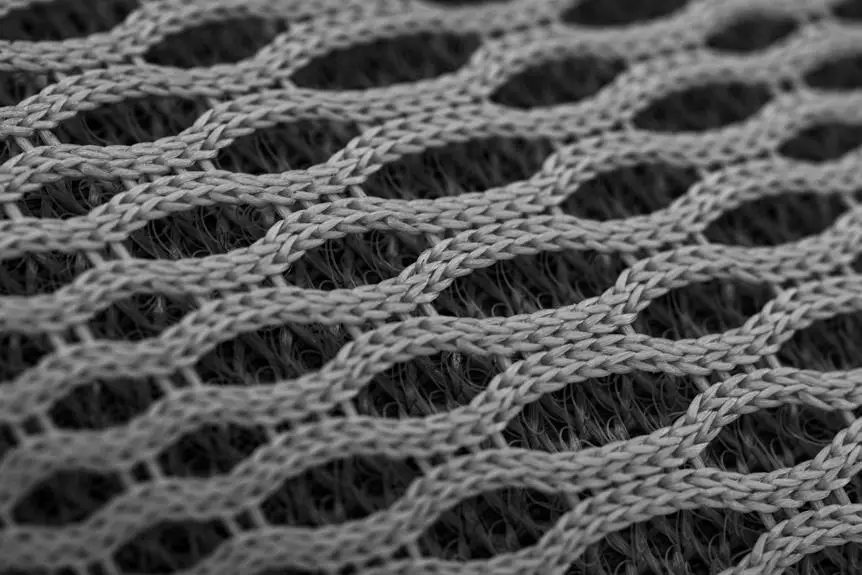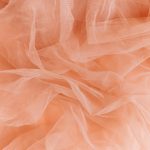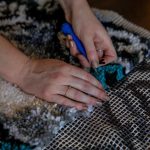When you're faced with the choice between muslin and cheesecloth, it's important to consider what you need them for. Muslin's soft texture and durability make it a versatile option for sewing and culinary tasks, while cheesecloth's loose weave is perfect for straining and cheese-making. Each fabric has its strengths, but the right choice depends on your specific applications. So, how do you determine which one will serve your projects best? Let's explore the key differences and common uses to help clarify your decision.
Table of Contents
Key Takeaways
- Muslin is ideal for sewing and crafting, while cheesecloth excels in culinary tasks like straining and cheese-making.
- Muslin has a tight weave and soft texture, whereas cheesecloth is loosely woven and coarse.
- Cheesecloth is often single-use, while muslin is more durable and suitable for repeated use.
- Muslin absorbs dyes well, making it great for creative projects; cheesecloth is mainly used for food applications.
What Is Muslin?
Muslin is a lightweight cotton fabric known for its breathability and versatility in various applications. You'll find it used in everything from clothing to home decor and even culinary tasks. Its soft texture and open weave make it ideal for garments, particularly in warm climates, as it allows air to circulate and keeps you cool.
In sewing, muslin is often employed as a test fabric, letting you create prototypes of garments without damaging your main fabric. This practice helps you check fit and design before committing to your final piece.
In the kitchen, muslin shines as a tool for straining liquids, wrapping herbs, or even making cheese. You can easily use it to create homemade nut milk or to steep teas without leaving behind any residue.
Another benefit of muslin is its ability to dye well, opening up creative avenues for your projects. Whether you're a seasoned designer or a home cook, muslin's adaptability makes it an essential fabric to have on hand.
With its numerous applications, you'll quickly appreciate why muslin has remained popular throughout the years.
What Is Cheesecloth?
Cheesecloth is a lightweight, loosely woven cotton fabric primarily used for straining liquids and wrapping food items. You'll often find it in kitchens, where it serves multiple purposes.
When you're making cheese, for instance, you can use cheesecloth to strain whey from curds, allowing you to achieve the desired texture. It's also great for making nut milk, as the fine weave keeps the liquid smooth while filtering out any solids.
If you're into home canning or preserving, cheesecloth can act as a protective cover for jars or help in straining homemade stocks and broths. Another useful application is in seasoning. You can wrap herbs and spices in cheesecloth to create a bouquet garni, making it easy to infuse flavors without leaving bits behind.
One of the highlights of cheesecloth is its versatility. You can find it in various grades, which determine how tightly woven the fabric is. Depending on your task, you might choose a finer weave for liquid straining or a coarser one for wrapping larger food items.
Cheesecloth is an essential tool for both novice and experienced cooks alike.
Key Differences Between Muslin and Cheesecloth
How do muslin and cheesecloth differ in terms of texture and application? Understanding these differences can help you choose the right fabric for your needs.
Muslin is a tightly woven fabric with a smooth texture, making it versatile for various applications. It's often used in sewing, crafting, and even as a lightweight curtain.
On the other hand, cheesecloth features a looser weave, which allows for better airflow and drainage, ideal for tasks requiring straining or filtering.
Here are some key differences to visualize:
- Texture: Muslin feels soft and smooth, while cheesecloth is more coarse and airy.
- Weave: Muslin has a tighter, denser weave, whereas cheesecloth is loosely woven with larger gaps.
- Durability: Muslin is more durable, suitable for repeated use in projects, while cheesecloth is often single-use or for light tasks.
Common Uses for Muslin
Muslin is incredibly versatile and can be used in various ways.
Whether you're tackling sewing projects, whipping up culinary creations, or selecting baby products, it proves to be a reliable choice.
Let's explore how muslin fits into these everyday applications.
Sewing and Craft Projects
Sewing enthusiasts often turn to muslin for its versatility in various craft projects, making it a staple in many creative endeavors.
Whether you're a seasoned pro or just starting out, muslin can elevate your work in numerous ways.
Here are some common uses for muslin in sewing and craft projects:
- Mock-ups and Patterns: Use muslin to create test garments, allowing you to perfect your fit without wasting expensive fabric.
- Quilting: Muslin serves as a fantastic backing fabric for quilts, providing a smooth, even surface.
- Drapery and Curtains: With its breathable quality, muslin works well for lightweight drapes that softly filter light.
Culinary Applications
In addition to its crafting benefits, muslin also shines in the culinary world with its many practical applications.
You can use muslin for straining stocks and broths, making it an ideal tool for achieving clear, flavorful liquids. Just pour your mixture into a muslin bag, and let gravity do the work for you.
Another fantastic use is for wrapping herbs and spices while cooking. By creating a sachet, you can infuse your dishes with delightful flavors without the hassle of finding stray herbs in your food. Muslin's breathable fabric allows the flavors to seep through while keeping everything contained.
If you're into cheesemaking, muslin is essential for draining curds and pressing cheese. Its fine weave ensures you get the right texture without losing any precious curds.
When it comes to making jams or jellies, you can use muslin to strain out pulp, resulting in a smooth, delicious spread.
Lastly, muslin can serve as a makeshift cover for rising dough, allowing it to breathe while preventing debris from falling in.
With these versatile culinary applications, muslin is a must-have in your kitchen toolkit!
Baby Products and Linens
When it comes to baby products and linens, muslin is a favorite choice for its softness and breathability, making it perfect for swaddles and blankets. When you wrap your little one in a muslin swaddle, you're not just providing warmth; you're ensuring comfort without overheating. The lightweight fabric allows air to circulate, which is crucial during those warm nights.
Muslin's versatility extends beyond swaddles. Here are some common uses you might love:
- Burp Cloths: Absorbent and easy to clean, perfect for catching those spills.
- Nursing Covers: Lightweight and breathable, providing privacy without making you or your baby too hot.
- Stroller Blankets: Great for on-the-go; they're compact and can be used for various purposes, like a light cover or shade.
Choosing muslin for your baby's products means you're prioritizing comfort and practicality. With its gentle touch and multiple uses, it's a must-have in any nursery.
Common Uses for Cheesecloth
Cheesecloth serves a variety of purposes, from straining liquids to wrapping herbs and spices for cooking. When you're making homemade stocks or broths, cheesecloth comes in handy to strain out solids while keeping the rich flavors intact. Simply line a colander with cheesecloth, pour in the mixture, and let gravity do the work.
You can also use cheesecloth for making cheese, such as ricotta or yogurt. By placing the curds in cheesecloth, you allow the whey to drain off, resulting in a smoother texture. It's a must-have for anyone interested in homemade dairy products.
Cheesecloth is great for wrapping herbs and spices in a bundle, making it easy to infuse flavors into soups and sauces without the hassle of fishing out individual leaves or seeds later. Additionally, you can use it for sprouting seeds, as its breathable fabric allows for proper airflow.
Lastly, cheesecloth is perfect for covering food during fermentation, such as for making sauerkraut or kimchi. Its lightweight nature protects your fermenting food while allowing gases to escape.
With so many uses, cheesecloth is an essential tool for any kitchen.
Advantages of Using Muslin
Muslin offers several advantages that make it a fantastic alternative to cheesecloth for various culinary tasks. When you choose muslin, you'll find it not only enhances your cooking experience but also provides practical benefits. Here are some key advantages:
Durability: Muslin's tightly woven fibers ensure it withstands repeated use, making it a long-lasting investment in your kitchen.
Versatility: Whether you're straining stocks, wrapping herbs, or making cheese, muslin adapts to various tasks effortlessly.
Fine Texture: Muslin's smooth surface allows for efficient straining without leaving behind any small particles, delivering cleaner results.
Easy to Clean: Muslin is machine washable, so you can quickly toss it in the laundry after use, saving you time and effort.
Advantages of Using Cheesecloth
When it comes to culinary uses, cheesecloth is incredibly versatile, making it a go-to for many kitchen tasks.
You'll also find it easy to clean and maintain, which saves you time and effort.
Plus, its affordability and accessibility make it a smart choice for any home cook.
Versatile Culinary Applications
With its fine weave and durability, cheesecloth offers a range of versatile culinary applications that can elevate your cooking and food preparation.
Whether you're a seasoned chef or a home cook, you'll find that cheesecloth can simplify many tasks in the kitchen.
Here are some ways you can use it:
- Straining stocks and broths: Achieve a clear, flavorful liquid by effortlessly filtering out herbs, spices, and solids.
- Making cheese: Create your own ricotta or yogurt cheese by letting the curds drain naturally, giving you fresh, creamy results.
- Wrapping spices: Bundle up whole spices in cheesecloth to infuse flavors into soups and stews without leaving gritty remnants behind.
These applications showcase how cheesecloth not only enhances your culinary experience but also makes it easier to experiment with new techniques.
Easy to Clean
Cheesecloth is incredibly easy to clean, making it a convenient choice for any home cook. Unlike other materials, you won't spend hours scrubbing or soaking it. Once you're done using it, simply rinse it under warm water to remove any food particles. If it's particularly stained or greasy, a little soap does the trick. You can toss it in the washing machine for a more thorough clean, but always check the care instructions first.
Check out the comparison below to see just how simple it is to maintain cheesecloth:
| Cleaning Method | Cheesecloth |
|---|---|
| Rinse after use | ✔️ |
| Machine washable | ✔️ |
| Requires special care | ❌ |
This ease of cleaning is a major advantage, especially when you're juggling multiple tasks in the kitchen. Plus, you can use cheesecloth repeatedly without worrying about wear and tear, making it an efficient choice for your culinary needs. You'll appreciate how it saves you time, allowing you to focus more on cooking and less on cleanup.
Affordable and Accessible
Cleaning cheesecloth is just the beginning of its benefits, as it's also incredibly affordable and easily accessible for any home chef. You don't need to break the bank to stock your kitchen with this versatile tool. Whether you're straining stocks, making cheese, or crafting herbal sachets, cheesecloth offers a budget-friendly solution that won't compromise on quality.
Here are some reasons why cheesecloth is a great choice:
- Cost-effective: Typically available for just a few dollars, you can find it at any grocery or craft store.
- Versatile: Use it for various culinary tasks like straining liquids, wrapping herbs, or even covering dough.
- Reusability: With proper care, you can wash and reuse cheesecloth multiple times, making it a sustainable option.
Frequently Asked Questions
Can Muslin Be Used for Quilting Projects?
Absolutely, you can use muslin for quilting projects! Its lightweight and breathable nature makes it perfect for backing or piecing. Just ensure you pre-wash it to prevent any shrinking or color bleeding later on.
Is Cheesecloth Safe for Food-Related Tasks?
Yes, cheesecloth is safe for food-related tasks. You can use it for straining liquids, wrapping herbs, or making cheese. Just ensure you're using unbleached, food-grade cheesecloth to avoid any harmful chemicals. Enjoy your cooking!
How Do I Properly Care for Muslin?
To care for muslin, you should wash it in cold water with a gentle detergent. Avoid bleach, and air-dry or tumble-dry on low. Store it in a cool, dry place to maintain its quality.
Can Cheesecloth Be Reused After Washing?
Yes, you can reuse cheesecloth after washing it. Just make sure to clean it thoroughly with mild soap and warm water, then let it dry completely before storing it for future use.
What Is the Best Way to Dye Muslin?
To dye muslin, you'll want to prewash it, then soak it in a dye bath. Stir occasionally for even color, and rinse thoroughly afterward. Let it air dry to preserve the vibrant hues. Enjoy your project!
- Finding the Perfect Brown Herringbone Wool Fabric for Your Project - June 19, 2025
- Key Characteristics of Herringbone Fabric: Texture, Durability, and Weave Explained - June 19, 2025
- The Pros and Cons of a Herringbone Fabric Couch - June 19, 2025





